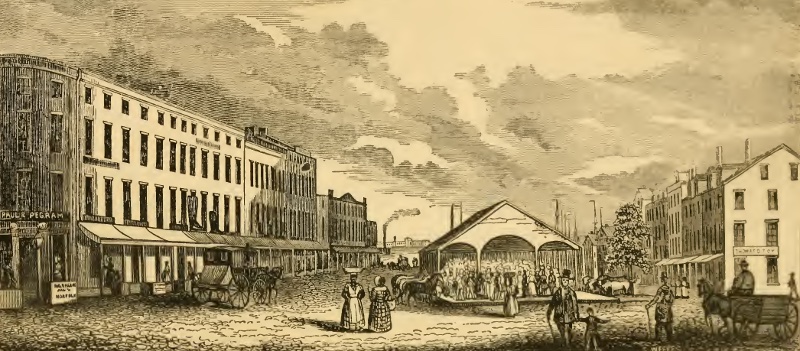
Pictured: Market in Norfolk, across the harbor to the shoreline at Portsmouth in 1845
Source: Historical collections of Virginia, Market Square, Norfolk (p.393)
Information obtained from Norfolk.gov
The 19th century in Norfolk saw the birth of key institutions and transformative events that left a lasting imprint on the city’s history. We’ve distilled this rich history into a concise overview to provide you with a glimpse of Norfolk’s past.
In 1800, the First Baptist Church on Bute Street became Norfolk’s first predominantly black congregation, marking a significant milestone. The city welcomed the establishment of the first Continental Navy Yard in 1801 and divided into eight wards in 1803, each electing its councilmen.
However, the early 1800s brought challenges, with a devastating fire in 1804 that consumed over 300 houses and warehouses south of Main Street.
Educational advancements were made in 1804 when Norfolk Academy, founded in 1728, received its charter from the General Assembly, securing its place as an educational institution.
Infrastructure improvements commenced in 1807 with an Act of Assembly that empowered the court of Norfolk Borough to pave streets. Yet, the same year, the Embargo Act disrupted business, closing ports and ceasing exportation, which resumed when the act was repealed in 1809.
In 1810, Fort Norfolk was constructed on the Elizabeth River, initially built during the Revolutionary War to protect the harbor. The city’s streets started to light up in 1811 when an Act of Assembly allowed the corporation to erect lamps for that purpose.
In 1814, the Dismal Swamp Canal opened trade routes between Norfolk and eastern North Carolina. In 1815, the arrival of the first steamboat, the Washington, in Portsmouth marked a significant technological advancement.
In 1819, land was ceded to the United States for the building of a customhouse, strengthening Norfolk’s position as a trade hub.
The Norfolk branch of the American Colonization Society was established in 1821, with Norfolk native Joseph Jenkins Roberts becoming the first president of Liberia. In 1832, the first steam ferry, the Gosport, began service between Norfolk and Portsmouth.
In the 1830s, the Wilkes Expedition sailed from Norfolk to explore the southern Pacific and Antarctica. Norfolk welcomed Prince Louis Napoleon in 1839.
The mid-19th century marked the construction of the United States Custom House in 1859. The political landscape shifted in 1861 when Virginia seceded from the Union. The city played a pivotal role in the Civil War, with events such as the first battle between ironclads – the Virginia and the Monitor – fought in Hampton Roads in 1862.
In 1862, Mayor Lamb surrendered the city to Union troops. Norfolk was occupied by Union forces under the command of General Benjamin Butler until 1865. In 1863, the Emancipation Proclamation went into effect.
The post-war years saw significant progress for the African-American community. In 1866, the True Southerner, the first black-owned newspaper in Norfolk, was published by Joseph T. Wilson.
The end of Reconstruction in Norfolk occurred in 1870, leading to the withdrawal of Union occupation troops, and African-Americans across Hampton Roads were elected to state and local offices. Norfolk County’s fertile farmland and waterways facilitated a swift recovery from the Civil War’s destruction.
By the late 19th century, Norfolk had introduced innovations such as horse-drawn trolleys in 1870, the establishment of the Norfolk Fire Department in 1871, and the introduction of electric trolleys in 1894, which connected Norfolk to various destinations.
Norfolk’s growth extended to education with the commencement of classes at the city’s first public high school in 1894. The region became a leader in truck farming, supplying greens and potatoes to the East Coast. Lynnhaven oysters became a major export, solidifying Norfolk’s role in trade.
As we look back at Norfolk’s 19th-century history, we see a city marked by change, resilience, and progress, a city that continued to evolve and thrive in the years to come.
SOURCE: Information obtained from Norfolk.gov